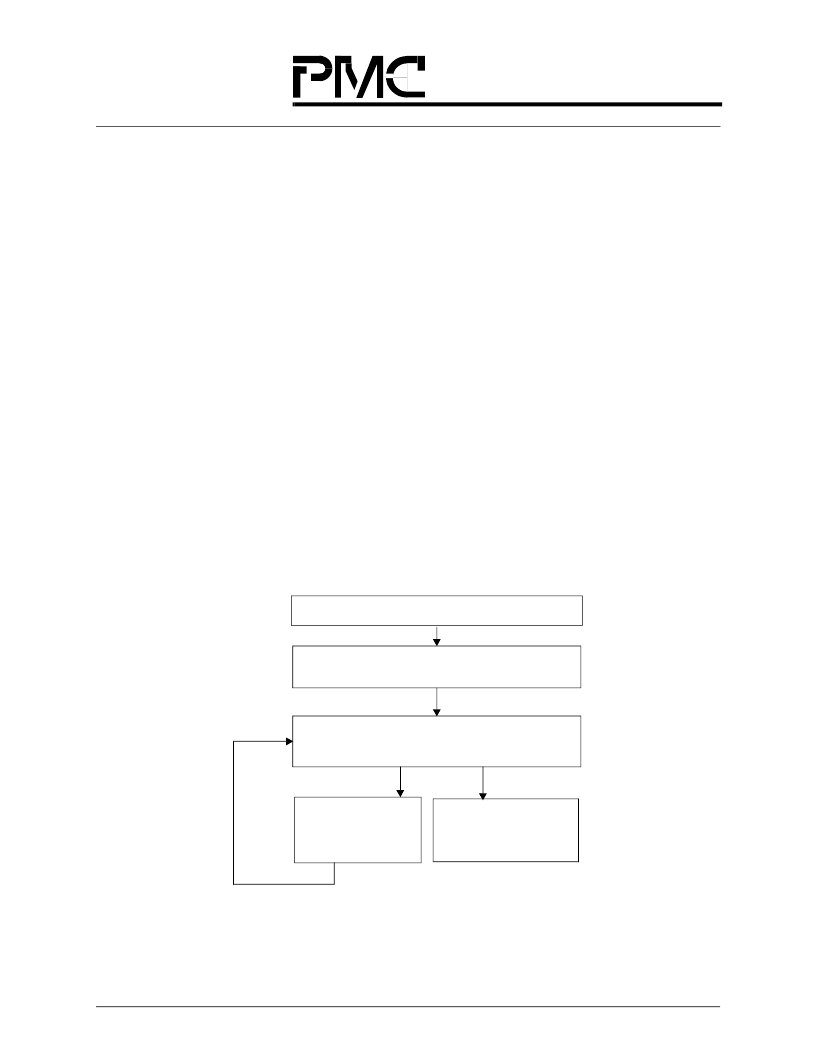- 您現(xiàn)在的位置:買(mǎi)賣(mài)IC網(wǎng) > PDF目錄378056 > PM73487-PI (PMC-SIERRA INC) 622 Mbps ATM Traffic Management Device PDF資料下載
參數(shù)資料
| 型號(hào): | PM73487-PI |
| 廠商: | PMC-SIERRA INC |
| 元件分類(lèi): | 數(shù)字傳輸電路 |
| 英文描述: | 622 Mbps ATM Traffic Management Device |
| 中文描述: | ATM/SONET/SDH SUPPORT CIRCUIT, PBGA503 |
| 封裝: | EPBGA-503 |
| 文件頁(yè)數(shù): | 52/251頁(yè) |
| 文件大?。?/td> | 3126K |
| 代理商: | PM73487-PI |
第1頁(yè)第2頁(yè)第3頁(yè)第4頁(yè)第5頁(yè)第6頁(yè)第7頁(yè)第8頁(yè)第9頁(yè)第10頁(yè)第11頁(yè)第12頁(yè)第13頁(yè)第14頁(yè)第15頁(yè)第16頁(yè)第17頁(yè)第18頁(yè)第19頁(yè)第20頁(yè)第21頁(yè)第22頁(yè)第23頁(yè)第24頁(yè)第25頁(yè)第26頁(yè)第27頁(yè)第28頁(yè)第29頁(yè)第30頁(yè)第31頁(yè)第32頁(yè)第33頁(yè)第34頁(yè)第35頁(yè)第36頁(yè)第37頁(yè)第38頁(yè)第39頁(yè)第40頁(yè)第41頁(yè)第42頁(yè)第43頁(yè)第44頁(yè)第45頁(yè)第46頁(yè)第47頁(yè)第48頁(yè)第49頁(yè)第50頁(yè)第51頁(yè)當(dāng)前第52頁(yè)第53頁(yè)第54頁(yè)第55頁(yè)第56頁(yè)第57頁(yè)第58頁(yè)第59頁(yè)第60頁(yè)第61頁(yè)第62頁(yè)第63頁(yè)第64頁(yè)第65頁(yè)第66頁(yè)第67頁(yè)第68頁(yè)第69頁(yè)第70頁(yè)第71頁(yè)第72頁(yè)第73頁(yè)第74頁(yè)第75頁(yè)第76頁(yè)第77頁(yè)第78頁(yè)第79頁(yè)第80頁(yè)第81頁(yè)第82頁(yè)第83頁(yè)第84頁(yè)第85頁(yè)第86頁(yè)第87頁(yè)第88頁(yè)第89頁(yè)第90頁(yè)第91頁(yè)第92頁(yè)第93頁(yè)第94頁(yè)第95頁(yè)第96頁(yè)第97頁(yè)第98頁(yè)第99頁(yè)第100頁(yè)第101頁(yè)第102頁(yè)第103頁(yè)第104頁(yè)第105頁(yè)第106頁(yè)第107頁(yè)第108頁(yè)第109頁(yè)第110頁(yè)第111頁(yè)第112頁(yè)第113頁(yè)第114頁(yè)第115頁(yè)第116頁(yè)第117頁(yè)第118頁(yè)第119頁(yè)第120頁(yè)第121頁(yè)第122頁(yè)第123頁(yè)第124頁(yè)第125頁(yè)第126頁(yè)第127頁(yè)第128頁(yè)第129頁(yè)第130頁(yè)第131頁(yè)第132頁(yè)第133頁(yè)第134頁(yè)第135頁(yè)第136頁(yè)第137頁(yè)第138頁(yè)第139頁(yè)第140頁(yè)第141頁(yè)第142頁(yè)第143頁(yè)第144頁(yè)第145頁(yè)第146頁(yè)第147頁(yè)第148頁(yè)第149頁(yè)第150頁(yè)第151頁(yè)第152頁(yè)第153頁(yè)第154頁(yè)第155頁(yè)第156頁(yè)第157頁(yè)第158頁(yè)第159頁(yè)第160頁(yè)第161頁(yè)第162頁(yè)第163頁(yè)第164頁(yè)第165頁(yè)第166頁(yè)第167頁(yè)第168頁(yè)第169頁(yè)第170頁(yè)第171頁(yè)第172頁(yè)第173頁(yè)第174頁(yè)第175頁(yè)第176頁(yè)第177頁(yè)第178頁(yè)第179頁(yè)第180頁(yè)第181頁(yè)第182頁(yè)第183頁(yè)第184頁(yè)第185頁(yè)第186頁(yè)第187頁(yè)第188頁(yè)第189頁(yè)第190頁(yè)第191頁(yè)第192頁(yè)第193頁(yè)第194頁(yè)第195頁(yè)第196頁(yè)第197頁(yè)第198頁(yè)第199頁(yè)第200頁(yè)第201頁(yè)第202頁(yè)第203頁(yè)第204頁(yè)第205頁(yè)第206頁(yè)第207頁(yè)第208頁(yè)第209頁(yè)第210頁(yè)第211頁(yè)第212頁(yè)第213頁(yè)第214頁(yè)第215頁(yè)第216頁(yè)第217頁(yè)第218頁(yè)第219頁(yè)第220頁(yè)第221頁(yè)第222頁(yè)第223頁(yè)第224頁(yè)第225頁(yè)第226頁(yè)第227頁(yè)第228頁(yè)第229頁(yè)第230頁(yè)第231頁(yè)第232頁(yè)第233頁(yè)第234頁(yè)第235頁(yè)第236頁(yè)第237頁(yè)第238頁(yè)第239頁(yè)第240頁(yè)第241頁(yè)第242頁(yè)第243頁(yè)第244頁(yè)第245頁(yè)第246頁(yè)第247頁(yè)第248頁(yè)第249頁(yè)第250頁(yè)第251頁(yè)

PM73487 QRT
PMC-Sierra, Inc.
PMC-980618
Issue 3
622 Mbps ATMTraffic Management Device
Released
Datasheet
40
choice of whether or not to send or drop one or more of the cells is affected by the EOF informa-
tion, because one frame that is being dropped may end, and another frame that is not to be
dropped may start.
2.6.5
Transmit Recovery Algorithm
No recovery algorithm is needed for the resequencing of one algorithm since the SN is ignored.
For resequencing of two algorithms, when a cell with SN
s
is received, and
s
is neither equal to
the expected cell number
e
, nor equal to
e + 1
, then the cell is dropped. The new expected SN (for
the next cell) is set at
s + 1.
The next time two consecutive cells are received in ascending SN
order, the channel will have recovered its sequence. Using this algorithm, some legitimate cells
may be dropped while recovering. For example,
if the next two cells are legitimate, but are
received in descending SN order, they will both be dropped.
2.6.6
Transmit Multicast Cell Background Process
The transmit multicast background process traverses the linked list for that channel and prepares a
list of pointers to cells and pointers to headers for multicast cells. This allows the dequeue process
to replicate the cell with new headers to each entry in the linked list. This is necessary because
multicast cells are bound to different destinations and need different headers.
Figure 45 shows the replication process that occurs, according to how the fields in the MC_LIST
word are set.
Figure 45. Multicast Background Process
Multicast cell is available in the input FIFO.
Look up the NEXT_MC_HEADER_PTR entry in the
TX_CHANNEL_TABLE pointed to by the OUT_CHAN.
1
Make an entry for the cell in the output FIFO for that
SC on the indicated VO. Increment the MC_COUNT
state bit. Check REPLICATE_CELL bit.
1
0
Look up the
NEXT_MC_ADD in the
multicast control block.
1
0
Move the head pointer in
the input FIFO and clear
ENQ_PEND state bit.
相關(guān)PDF資料 |
PDF描述 |
|---|---|
| PM73487 | 622 Mbps ATM Traffic Management Device |
| PM73488-PI | 5 Gbit/s ATM Switch Fabric Element |
| PM73488 | 5 Gbit/s ATM Switch Fabric Element |
| PM7349 | Ultraframer DS3/E3/DS2/E2/DS1/E1/DS0 |
| PM7350 | Dual Serial Link, PHY Multiplexer |
相關(guān)代理商/技術(shù)參數(shù) |
參數(shù)描述 |
|---|---|
| PM73488 | 制造商:PMC 制造商全稱(chēng):PMC 功能描述:5 Gbit/s ATM Switch Fabric Element |
| PM73488PI | 制造商:未知廠家 制造商全稱(chēng):未知廠家 功能描述:Telecommunication IC |
| PM73488-PI | 制造商:Rochester Electronics LLC 功能描述: 制造商:PMC-Sierra 功能描述: |
| PM7349 | 制造商:PMC 制造商全稱(chēng):PMC 功能描述:Quad J2, E3 and DS-3 Framer |
發(fā)布緊急采購(gòu),3分鐘左右您將得到回復(fù)。